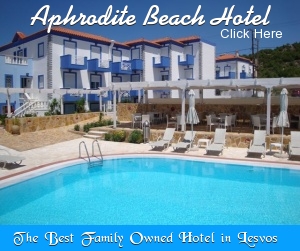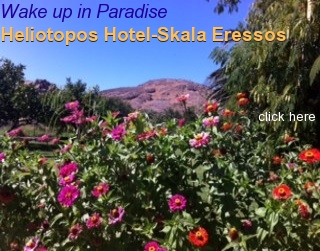|
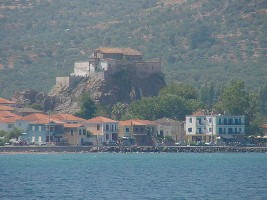 Glykfylousa
Panagia (Our Lady of the Sweet Kiss) sits on
top of a giant rock in the center of the town
of
Petra
. You reach the top of the rock by climbing
the 114 steps carved into the stone. From the
church the view of Petra and the surrounding
sea and countryside is spectacular extending
all the way to the coast of Asia Minor. A
beautiful legend concerning the building of
the church on this high rock has come down to
us: In days of old a storm bought a religious
captain to the shores of the area. One morning
the captain noticed that the Icon of the
Blessed Virgin, which he always had with him,
was missing. He looked for it everywhere but
to no avail. That evening he saw a strange
light shining seemingly suspended between sky
and earth. He climbed up the rock and found
his icon placed before a lighted lamp. He took
it back to his boat but again it disappeared
and again he found it on top of the rock. He
decided to build a small church there since
that was obviously the wish of the Blessed
Virgin. The first church was built in 1609 and
the present one in 1747. There is a great
celebration there on August 15th. Below the
rock is the tiny Church of Agios Nikolaos.
Inside, the small church is decorated with
16th century wall paintings that are colorful
and inspirational and worth a trip to the
village.
Glykfylousa
Panagia (Our Lady of the Sweet Kiss) sits on
top of a giant rock in the center of the town
of
Petra
. You reach the top of the rock by climbing
the 114 steps carved into the stone. From the
church the view of Petra and the surrounding
sea and countryside is spectacular extending
all the way to the coast of Asia Minor. A
beautiful legend concerning the building of
the church on this high rock has come down to
us: In days of old a storm bought a religious
captain to the shores of the area. One morning
the captain noticed that the Icon of the
Blessed Virgin, which he always had with him,
was missing. He looked for it everywhere but
to no avail. That evening he saw a strange
light shining seemingly suspended between sky
and earth. He climbed up the rock and found
his icon placed before a lighted lamp. He took
it back to his boat but again it disappeared
and again he found it on top of the rock. He
decided to build a small church there since
that was obviously the wish of the Blessed
Virgin. The first church was built in 1609 and
the present one in 1747. There is a great
celebration there on August 15th. Below the
rock is the tiny Church of Agios Nikolaos.
Inside, the small church is decorated with
16th century wall paintings that are colorful
and inspirational and worth a trip to the
village.
|
|
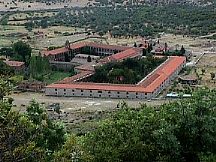 Many of the old
Monasteries of Lesvos are still in use. Some
have become destinations for pilgrimages while
others carry on the spiritual tradions
of long ago.
Leimonos
Monastery
, (pictured on left) built in 1523 is a large
cluster of buildings between Kaloni and Filia.
It is an important spiritual center on the
island with a museum, a library and social
services. Overnight stays are possible. They
have a festival here celebrating Ag. Ignatious
on the second weekend of October. Nearby the Monastery of Metochi is being used as a scholarly and spiritual retreat with courses and seminars (in English) about the important questions of life such as Love, Peace, Good and Evi.
Many of the old
Monasteries of Lesvos are still in use. Some
have become destinations for pilgrimages while
others carry on the spiritual tradions
of long ago.
Leimonos
Monastery
, (pictured on left) built in 1523 is a large
cluster of buildings between Kaloni and Filia.
It is an important spiritual center on the
island with a museum, a library and social
services. Overnight stays are possible. They
have a festival here celebrating Ag. Ignatious
on the second weekend of October. Nearby the Monastery of Metochi is being used as a scholarly and spiritual retreat with courses and seminars (in English) about the important questions of life such as Love, Peace, Good and Evi.
A modern day phenomenon is the
developing
Monastery of
Agiou Raphael
in Thermi. People
come from all over Greece to the shrine of the
Newly Sanctified Martyrs of Raphael, the
Father Superior of the destroyed monastery, of
Nikolas, the deacon, and the young Irene, all
three of whom died as martyrs at the hands of
the Turks in 1463. A miracle was responsible
for the discovery of the bodies of the saints,
by Angelos Rallis, who donated the land for
the monastery. This monastery is constantly
visited year-round by pilgrims searching for a
miracle. The complex has rooms for overnight
stays. There is a celebration here on the
Tuesday after Easter.
|
|
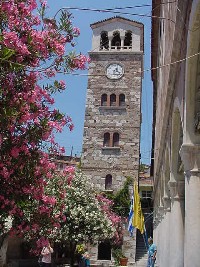 In
Agiassos
the Virgin Mary is
venerated and everything revolves around the
miracle working icon of the Blessed Virgin
Vrefokratousa and the
Church of the
Panagia.
During a two week period leading up to the
15th of August, which is the Holy Day of the
Virgin Mary, pilgrims begin flocking to the
town not only from Lesvos but all over Greece,
slowly building up to a carnival-like
atmosphere, peaking on the eve of the feast
day. There is another festival on September
14th commemorating the day when the Holy cross
which Mytilinians brought back from Jerusalem
after it was consecrated on Golgotha.
Agathon's Cross was made with wood from the
True Cross and is kept in the museum of the
church. The church is surrounded by shops
selling icons and religious items as well as
some of the best cafeneons on the
island.
In
Agiassos
the Virgin Mary is
venerated and everything revolves around the
miracle working icon of the Blessed Virgin
Vrefokratousa and the
Church of the
Panagia.
During a two week period leading up to the
15th of August, which is the Holy Day of the
Virgin Mary, pilgrims begin flocking to the
town not only from Lesvos but all over Greece,
slowly building up to a carnival-like
atmosphere, peaking on the eve of the feast
day. There is another festival on September
14th commemorating the day when the Holy cross
which Mytilinians brought back from Jerusalem
after it was consecrated on Golgotha.
Agathon's Cross was made with wood from the
True Cross and is kept in the museum of the
church. The church is surrounded by shops
selling icons and religious items as well as
some of the best cafeneons on the
island.
In
Mandamados
at
theChurch
of
Taxiarches
, the miracle working saint of the island is
woshipped. The carved icon was made by a monk
using mud and the blood of his fallen comrades
after being miraculously saved by Saracen
pirates. The church celebrates on the third
Sunday after easter with a festival that
includes the slaughtering of a concecrated
bull whose meat is shared among the
worshippers. Another religious celebration is
held here on the third Sunday after
Easter.
|
|
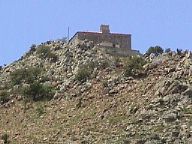 Ypsilou
Monastery
(pictured on left)
is built on the crater of a dormant volcano.
This monastery was built in 1101. It houses
some remarkable gold embroided stoles and
bible covers from 1588. It is located on the
road to Sigri right past the turnoff to
Eressos. From it's heights you can see the
coast of Asia Minor and all of the western
portion of the island.
There are signs
all over that tell you that photographs are
not allowed so this picture is about the best
I could do. If you are visiting the
petrified forest
be sure to stop
here too.
Ypsilou
Monastery
(pictured on left)
is built on the crater of a dormant volcano.
This monastery was built in 1101. It houses
some remarkable gold embroided stoles and
bible covers from 1588. It is located on the
road to Sigri right past the turnoff to
Eressos. From it's heights you can see the
coast of Asia Minor and all of the western
portion of the island.
There are signs
all over that tell you that photographs are
not allowed so this picture is about the best
I could do. If you are visiting the
petrified forest
be sure to stop
here too.
There are two spectacular churches in the village of Vatousa, one in the main square and the other by the school, which is the older one and is usually locked. You may be able to get the key from someone in the town hall or one of the cafeneons if you ask.
|
|
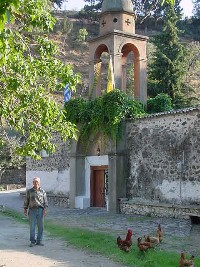 The
Perivoli
Monastery
(pictured at
right) sits in a beautiful green valley
between Vatoussa and
Antissa.
It is serene and the caretaker is happy to
show you around.
Perivoli
means garden. The
monastery has some very important wall
paintings from the sixteenth century though
the church itself was built in the 1300's.
There are picnic tables in the grove of trees
outside the outer walls
of the
monastery.
The caretaker is a
very charming guy who speaks some English and
talks Greek in rhymes. Because of it's
location the monastery seems almost forgotten
but it is well worth the visit even if just to
talk to the caretaker. This is my favorite
monastery on the island and one of my
favorites in Greece. The road between Vatoussa
and Antissa has an unfortunate odor due to the
cheese factory that dumps its waste into the
stream and for this reason many people try to
get past the area as quickly as possible,
espeically those who can't roll up the windows
because they are on motorbikes or in an open
jeep. Some see the sign for the monastery but
don't stop fearing the road into the valley
will just bring them closer to the cheese
smell. But the monastery has so far escaped
and even the smelly cheese factory would have
a problem overcoming the scent of the flowers,
plants and trees in full bloom.
The
Perivoli
Monastery
(pictured at
right) sits in a beautiful green valley
between Vatoussa and
Antissa.
It is serene and the caretaker is happy to
show you around.
Perivoli
means garden. The
monastery has some very important wall
paintings from the sixteenth century though
the church itself was built in the 1300's.
There are picnic tables in the grove of trees
outside the outer walls
of the
monastery.
The caretaker is a
very charming guy who speaks some English and
talks Greek in rhymes. Because of it's
location the monastery seems almost forgotten
but it is well worth the visit even if just to
talk to the caretaker. This is my favorite
monastery on the island and one of my
favorites in Greece. The road between Vatoussa
and Antissa has an unfortunate odor due to the
cheese factory that dumps its waste into the
stream and for this reason many people try to
get past the area as quickly as possible,
espeically those who can't roll up the windows
because they are on motorbikes or in an open
jeep. Some see the sign for the monastery but
don't stop fearing the road into the valley
will just bring them closer to the cheese
smell. But the monastery has so far escaped
and even the smelly cheese factory would have
a problem overcoming the scent of the flowers,
plants and trees in full bloom.
|
|
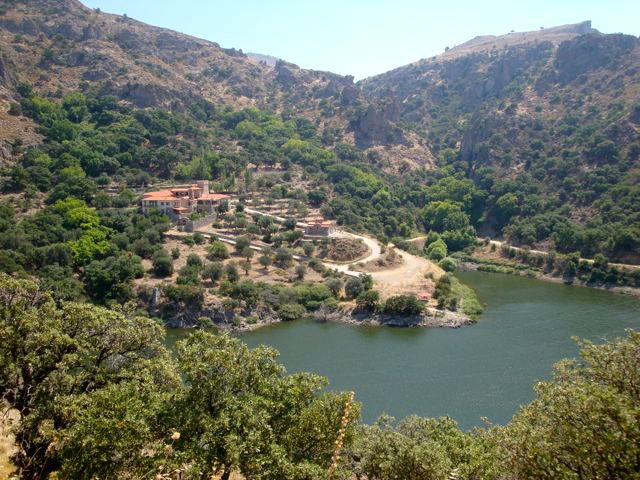 The monastery
of
Pithari
, founded in the seventeenth century is also
close to Eressos. Surrounded by a grove of oak
and sycamore trees in a dramatic gorge, it's
an enjoyable walk there but you can also get
there by car. The monastery is dedicated to
the Taxiarchis (archangels) whose panagiri day
is November 8th. There is a disciplinary
center for the clergy there.
Recently they have added a lake. Yes: a lake. An enormous lake that supplies the agricultural valley of Eressos with water. You gotta see it to believe it. You will think you are in the Swiss Alps. I spoke to the Bishop of Mytilini and he told me that I should let people know that the monks would love visitors. You can get there by following the signs on the road from Eressos to Mytilini though it is a much easier drive if you go from the road between Skala Eressos and
Mesotopos. The monastery
of
Pithari
, founded in the seventeenth century is also
close to Eressos. Surrounded by a grove of oak
and sycamore trees in a dramatic gorge, it's
an enjoyable walk there but you can also get
there by car. The monastery is dedicated to
the Taxiarchis (archangels) whose panagiri day
is November 8th. There is a disciplinary
center for the clergy there.
Recently they have added a lake. Yes: a lake. An enormous lake that supplies the agricultural valley of Eressos with water. You gotta see it to believe it. You will think you are in the Swiss Alps. I spoke to the Bishop of Mytilini and he told me that I should let people know that the monks would love visitors. You can get there by following the signs on the road from Eressos to Mytilini though it is a much easier drive if you go from the road between Skala Eressos and
Mesotopos. |
|
The tiny
Church of Saint
Andrew
in
Skala Eressos
sits on a quiet
shaded road next to the cathedral of Saint
Andrew and the ruins of the ancient basilica
of the same name. The saint himself, whose
body lay in repose for many years until
returned to his native Crete in the nineteenth
century, died in a shipwreck off the coast of
Eressos. The church is also next to the
archeological museum. There are many churches
around the island which celebrate on the name
days of their patron saints. If you ask in the
town you are staying in they will tell you
when these festivals (panagiris) take place.
Some of the more remote villages have
interesting festivals with aspects that seem
to have remnants of pagan times. Some
festivals have horse races as part of the
festivities and attract all sorts of people
selling anything from icons to bootleg pop
music CD's. The bigger festivals put up
posters around the island.
|
|
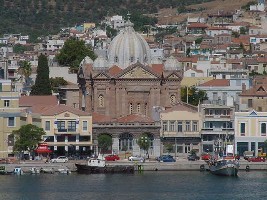 In
Mytilini
there are several
important churches including the
Cathedral of
Saint Athanasios
whioch was built
at the end of the 16th Century and has a
secret underground tomb. The sacred relics of
Saint Theodore, hung by the Turks in 1795 are
kept here and his martyrdom is celebrated
February 17th and also on the 4th Sunday after
Easter. The saint has been credited with
saving the island from a plague in 1836. The
largest church in Mytilini is
Saint
Therapon
(photo) built in
1860, which is just behind the habor road in
the market. Supposedly the church sits on top
of an ancient temple to Apollo. Both churches
are full of Byzantine icons and impressive
wood-carvings and gold. Also nearby is
the
Church of Saint
Theodore
a triple-aisled
baslica and the church of Saint Nicholas, a
converted mosque.
In
Mytilini
there are several
important churches including the
Cathedral of
Saint Athanasios
whioch was built
at the end of the 16th Century and has a
secret underground tomb. The sacred relics of
Saint Theodore, hung by the Turks in 1795 are
kept here and his martyrdom is celebrated
February 17th and also on the 4th Sunday after
Easter. The saint has been credited with
saving the island from a plague in 1836. The
largest church in Mytilini is
Saint
Therapon
(photo) built in
1860, which is just behind the habor road in
the market. Supposedly the church sits on top
of an ancient temple to Apollo. Both churches
are full of Byzantine icons and impressive
wood-carvings and gold. Also nearby is
the
Church of Saint
Theodore
a triple-aisled
baslica and the church of Saint Nicholas, a
converted mosque.
|
|
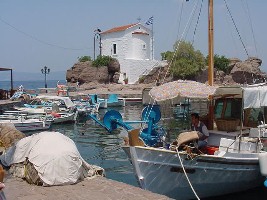 One can't have a
web-page of churches in Lesvos without
mentioning the beautiful little church of
the
Panagia Tis
Gorgonas
(The Mermaid
Madonna) or also known as Panagia Ton Psaradon
(The Madonna of the Fishermen), made famous in
the wonderful book The Mermaid Madonna by
Stratis Myrivilis, one of Lesvos and Greece's
greatest writers. His books are a facinating
study of the people and life in Lesvos in the
early 20th century and are excellent reading
companions. Every village has at least one
main church and a number of smaller ones and
there are also small churches scattered around
the countryside. Some of the churches in the
traditonal villages are as impressive or more
so than those mentioned here. Exeptional
churches are in the villages of Megalohori
near Plomari and there are two beautiful old
churches in Vatoussa.
One can't have a
web-page of churches in Lesvos without
mentioning the beautiful little church of
the
Panagia Tis
Gorgonas
(The Mermaid
Madonna) or also known as Panagia Ton Psaradon
(The Madonna of the Fishermen), made famous in
the wonderful book The Mermaid Madonna by
Stratis Myrivilis, one of Lesvos and Greece's
greatest writers. His books are a facinating
study of the people and life in Lesvos in the
early 20th century and are excellent reading
companions. Every village has at least one
main church and a number of smaller ones and
there are also small churches scattered around
the countryside. Some of the churches in the
traditonal villages are as impressive or more
so than those mentioned here. Exeptional
churches are in the villages of Megalohori
near Plomari and there are two beautiful old
churches in Vatoussa.
|

 Glykfylousa
Panagia (Our Lady of the Sweet Kiss) sits on
top of a giant rock in the center of the town
of
Glykfylousa
Panagia (Our Lady of the Sweet Kiss) sits on
top of a giant rock in the center of the town
of
 Many of the old
Monasteries of Lesvos are still in use. Some
have become destinations for pilgrimages while
others carry on the spiritual tradions
of long ago.
Leimonos
Monastery
, (pictured on left) built in 1523 is a large
cluster of buildings between Kaloni and Filia.
It is an important spiritual center on the
island with a museum, a library and social
services. Overnight stays are possible. They
have a festival here celebrating Ag. Ignatious
on the second weekend of October. Nearby the
Many of the old
Monasteries of Lesvos are still in use. Some
have become destinations for pilgrimages while
others carry on the spiritual tradions
of long ago.
Leimonos
Monastery
, (pictured on left) built in 1523 is a large
cluster of buildings between Kaloni and Filia.
It is an important spiritual center on the
island with a museum, a library and social
services. Overnight stays are possible. They
have a festival here celebrating Ag. Ignatious
on the second weekend of October. Nearby the  Ypsilou
Monastery
(pictured on left)
is built on the crater of a dormant volcano.
This monastery was built in 1101. It houses
some remarkable gold embroided stoles and
bible covers from 1588. It is located on the
road to Sigri right past the turnoff to
Eressos. From it's heights you can see the
coast of Asia Minor and all of the western
portion of the island.
There are signs
all over that tell you that photographs are
not allowed so this picture is about the best
I could do. If you are visiting the
Ypsilou
Monastery
(pictured on left)
is built on the crater of a dormant volcano.
This monastery was built in 1101. It houses
some remarkable gold embroided stoles and
bible covers from 1588. It is located on the
road to Sigri right past the turnoff to
Eressos. From it's heights you can see the
coast of Asia Minor and all of the western
portion of the island.
There are signs
all over that tell you that photographs are
not allowed so this picture is about the best
I could do. If you are visiting the
 The monastery
of
Pithari
, founded in the seventeenth century is also
close to Eressos. Surrounded by a grove of oak
and sycamore trees in a dramatic gorge, it's
an enjoyable walk there but you can also get
there by car. The monastery is dedicated to
the Taxiarchis (archangels) whose panagiri day
is November 8th. There is a disciplinary
center for the clergy there.
Recently they have added a lake. Yes: a lake. An enormous lake that supplies the agricultural valley of Eressos with water. You gotta see it to believe it. You will think you are in the Swiss Alps. I spoke to the Bishop of Mytilini and he told me that I should let people know that the monks would love visitors. You can get there by following the signs on the road from Eressos to Mytilini though it is a much easier drive if you go from the road between Skala Eressos and
Mesotopos.
The monastery
of
Pithari
, founded in the seventeenth century is also
close to Eressos. Surrounded by a grove of oak
and sycamore trees in a dramatic gorge, it's
an enjoyable walk there but you can also get
there by car. The monastery is dedicated to
the Taxiarchis (archangels) whose panagiri day
is November 8th. There is a disciplinary
center for the clergy there.
Recently they have added a lake. Yes: a lake. An enormous lake that supplies the agricultural valley of Eressos with water. You gotta see it to believe it. You will think you are in the Swiss Alps. I spoke to the Bishop of Mytilini and he told me that I should let people know that the monks would love visitors. You can get there by following the signs on the road from Eressos to Mytilini though it is a much easier drive if you go from the road between Skala Eressos and
Mesotopos. One can't have a
web-page of churches in Lesvos without
mentioning the beautiful little church of
the
Panagia Tis
Gorgonas
(The Mermaid
Madonna) or also known as Panagia Ton Psaradon
(The Madonna of the Fishermen), made famous in
the wonderful book The Mermaid Madonna by
Stratis Myrivilis, one of Lesvos and Greece's
greatest writers. His books are a facinating
study of the people and life in Lesvos in the
early 20th century and are excellent reading
companions. Every village has at least one
main church and a number of smaller ones and
there are also small churches scattered around
the countryside. Some of the churches in the
traditonal villages are as impressive or more
so than those mentioned here. Exeptional
churches are in the villages of Megalohori
near Plomari and there are two beautiful old
churches in Vatoussa.
One can't have a
web-page of churches in Lesvos without
mentioning the beautiful little church of
the
Panagia Tis
Gorgonas
(The Mermaid
Madonna) or also known as Panagia Ton Psaradon
(The Madonna of the Fishermen), made famous in
the wonderful book The Mermaid Madonna by
Stratis Myrivilis, one of Lesvos and Greece's
greatest writers. His books are a facinating
study of the people and life in Lesvos in the
early 20th century and are excellent reading
companions. Every village has at least one
main church and a number of smaller ones and
there are also small churches scattered around
the countryside. Some of the churches in the
traditonal villages are as impressive or more
so than those mentioned here. Exeptional
churches are in the villages of Megalohori
near Plomari and there are two beautiful old
churches in Vatoussa.
